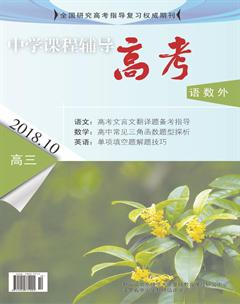单项填空题解题技巧
刘华
近几年,江苏高考英语卷单项填空题的设题内容新颖,贴近生活。但题干灵活,学生难免审题不清,产生不必要的失分。本文旨在通过分析试题,让学生能够准确理解命题者的意图和目的,掌握单项填空题的解题策略与技巧,坚定攻克单选题的信心。
单项填空题中的句子千变万化,学生要识别和理解变化了的句子结构,具备应变能力。
要想答好单项填空题,首先应具备扎实的基础知识,还要有正确审题和分析考题的能力。在审题时,既要全面、仔细并正确理解所有的已知条件,又要心中明了该题检测的是哪方面的知识或能力,然后使用相应解题的策略。
一、化简法
很多单项选择为了干扰学生的理解,增加了句子成分和修饰语,如各种从句、同位语、插入语等。做此类题时,应先搁置附加成分,使句子结构简化,找出主干,再逐步理解其他修饰成分。
例如:
1. The person we spoke to no answer at first.
A. make B. making
C. makes D. made
分析:可以看出we spoke to在句中是一個定语从句。将其去掉后,我们就会发现主句少了一个谓语动词。故本题选D。
2. More efforts, as reported, in the years ahead to accelerate the supply-side structural reform.
A. are made B. will be made
C. are being made D. have been made
分析:可以看出as reported为插入语,可先将其去掉。根据时间状语in the years ahead可知用一般将来时。故本题答案为B。
3. “Never for a second,” the boy says, “ that my father would come to my rescue.”
A. I doubted B. do I doubt
C. I have doubted D. did I doubt
分析:分析句子可知 the boy says 为插入语。句子可化简为Never for a second did I doubt that my father would come to my rescue。否定词放在句首,主句用部分倒装,又根据would可知,用助动词did。
二、补全法
有些题目使用省略法,省略部分可以理解的内容。对此可以根据句子结构将其补全,找出解题的突破点。
1. —Where did you get to know your wife?
—It was in the university we studied together.
A. that B. where
C. when D. which
分析:句意:——你在什么地方认识你的妻子? ——在我们一起学习的大学。根据It was 可知,句子为强调句型,省略了回答,补充完整应该是It was in the university where we studied together that I got to know my wife. 故答案为B,where 引导定语从句修饰university。
2. —What made her mother so angry?
— the exam.
A. Because she didnt pass
B. Her not passing
C. She didnt pass
D. Because her not passing
分析:根据句意,回答部分应为:她没有通过考试使她的妈妈生气。所以答句为省略回答,补充完整为Her not passing the exam made her mother so angry. 故答案为B。
3. Be careful when you deal with this chemical, as it will explode when to sunlight.
A. being exposed B. to expose
C. exposing D. exposed
分析:句意:当你处理这种化学物质的时候要小心,因为当被暴露于阳光下时,它将会爆炸。when 引导时间状语从句,用了省略的结构,补充完整为when it is exposed to sunlight. 故答案为D。
三、还原法
一些单项填空题的测试点本来十分简单,但命题者有意把题干复杂化,改写为一个少见或陌生的结构。对于这类题,应试者可以反其道而行,把题干还原为自己熟悉的结构,这样题目就会变得简单,答案就会一目了然,具体来说,可采用以下几种方法:
1. 将倒装句改成陈述句。如:
Whom would you rather have with you?
A. to go B. go
C. gone D. going
分析:若將本题题干改成陈述句,则应是:Would you rather have whom with you?这样我们一眼就可以看出答案为B。测试的知识点是使役动词have的宾语补足语用省去to 的动词不定式,表示将要发生的动作。
Difficult as rumors on micro blog or Weibo are , the authorities will step up supervision, so that people will not be easily misled.
A. preventing B. to be prevented
C. to prevent D. being prevented
分析:as引导让步状语从句用倒装结构,可以还原为Though rumors on micro blog or Weibo are difficult to prevent,形容词后的不定式用主动表被动,故答案为C。
2. 将陈述句改为倒装句。我们首次接触时是一个倒装句,而命题者恰恰是有意地使用陈述句来命题。如:
We had left home than it began to rain.
A. no sooner B. hardly
C. almost D. nearly
分析:no sooner...than是一个大家十分熟悉的句型。在考查知识点时,命题者却使用了一个陈述句。如果把题干改成: had we left home than it began to rain,这道题的答案选A也就变得十分清楚了。
We had arrived at the railway station when the train began to move.
A. no sooner B. hardly
C. almost D. nearly
分析:如果把本题改为倒装句,句子的结构就变得很熟悉了,本题考查的是句型hardly...when,因此,答案应为B。
3. 将被动句改为主动句。被动句的句子结构相对于主动句来说没有那么清楚,我们如果将其改为主动句,这类题就会变得清楚得多。如:
Time should be made good use of our lessons well.
A. learning B. learned
C. to learn D. learns
分析:将题干改写为主动句则为:We should make good use of time our lesson well。由此可见介词of 有其相应的宾语,其后不能再用动名词做宾语,应选不定式作目的状语。答案为C。
The little boy was caught in the shop.
A. to steal B. stealing
C. steal D. stolen
分析:改为主动句,则为:The salesman caught the boy in the shop,很容易看出考查的知识点是catch sb. doing sth.,故应选B。
四、巧用标点符号
句中逗号可以提示从句或为非限制性定语从句或非谓语动词作状语等。因此,注意标点提示可以避免不必要的误选。
1. Mary was much kinder to Jack than she was to the others, , of course, made all the others upset.
A. who B. which
C. what D. that
分析:考查定语从句,made 前面缺乏主语,of course为插入语,逗号前面整句话为made的主语,有逗号隔开,可推断该从句为非限制性定语从句,故用which 引导定语从句,不用that。答案为B。
2. There are two rooms on the first floor, is used as a guest room.
A. a smaller of which B. a smaller of them
C. the smaller of which D. the smaller of them
分析:定语从句的考查,两者当中的另一个用the smaller,又因为空格前为逗号,所以为非限制性定语从句,答案为C。如果把逗号改为句号,则选D。
3. Tom, sure to come tomorrow.
A. is B. be
C. was D. would be
分析:空格前有逗号,此句为对Tom 发出的指令,为祈使句,故答案为B。
4. All the money , John had to start looking for a job.
A. was cost B. had cost
C. having been spent D. having spent
分析:逗号前后的句子没有连词,故A,B两项排除。此句用独立主格结构作状语,根据句意,钱已经被花光了。故答案为C。
五、克服思维定势
命题者会利用考生的思维定势命题,学生不能用汉语的习惯思维方式去认识和解决英语中的一些问题,要认真分析句子语境,切忌死搬硬套。
1. The car passed by at was a dangerous speed.
A. which B. that
C. what D. why
分析:由于思維定势,at which 引导定语从句,容易误选A。但选择which没有先行词。故答案为C。The car passed by at what was a dangerous speed. 等于The car passed by at the speed which was a dangerous speed.
2. Could you tell me your address is?
A. where B. what
C. how D. which
分析:学生如果根据中文含义:你能否告诉我你的地址在哪儿?容易误选A。但问地址时常用的句型为“Whats your address?”故选择B,用what 充当be 动词的表语。
3. After 10 years of hard time, the young lady has turned movie star, she dreamed of becoming in her childhood.
A. who B. which
C. that D. what
分析:movie star 为一个人,所以容易误选A。但此处的movie star应视为“某种职业”,她梦想从事某种职业,而不是成为什么人。故答案为B。
4. Nathalie suggested the problem worth paying attention at the meeting.
A. to be discussed B. to been discussed
C. to being discussed D. should be discussed
分析:由于思维定势pay attention to doing sth. 容易误选C。但该句句意为:Nathalie建议那个值得注意的问题应该在会上讨论一下,worth paying attention to是定语,修饰the problem, 故答案为D。suggest后面的宾语从句谓语部分用should+动词原形。
虽然学生在单项填空题方面失分较多,但并非无章可循。巧妙地运用上述方法,就能各个击破,迎刃而解。当然,最重要的还是巩固基础知识,吃透每个知识点。

